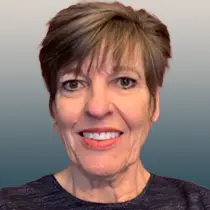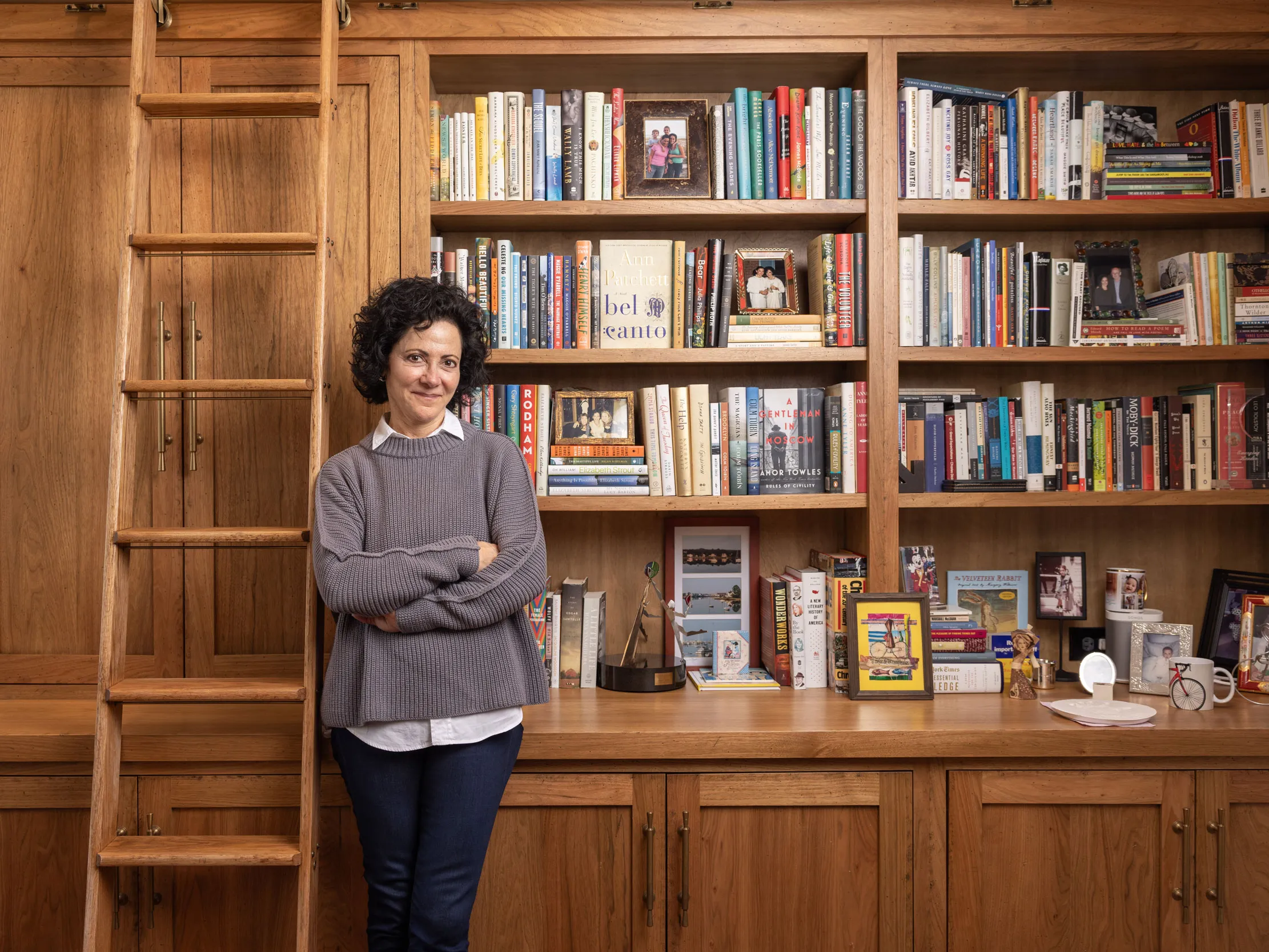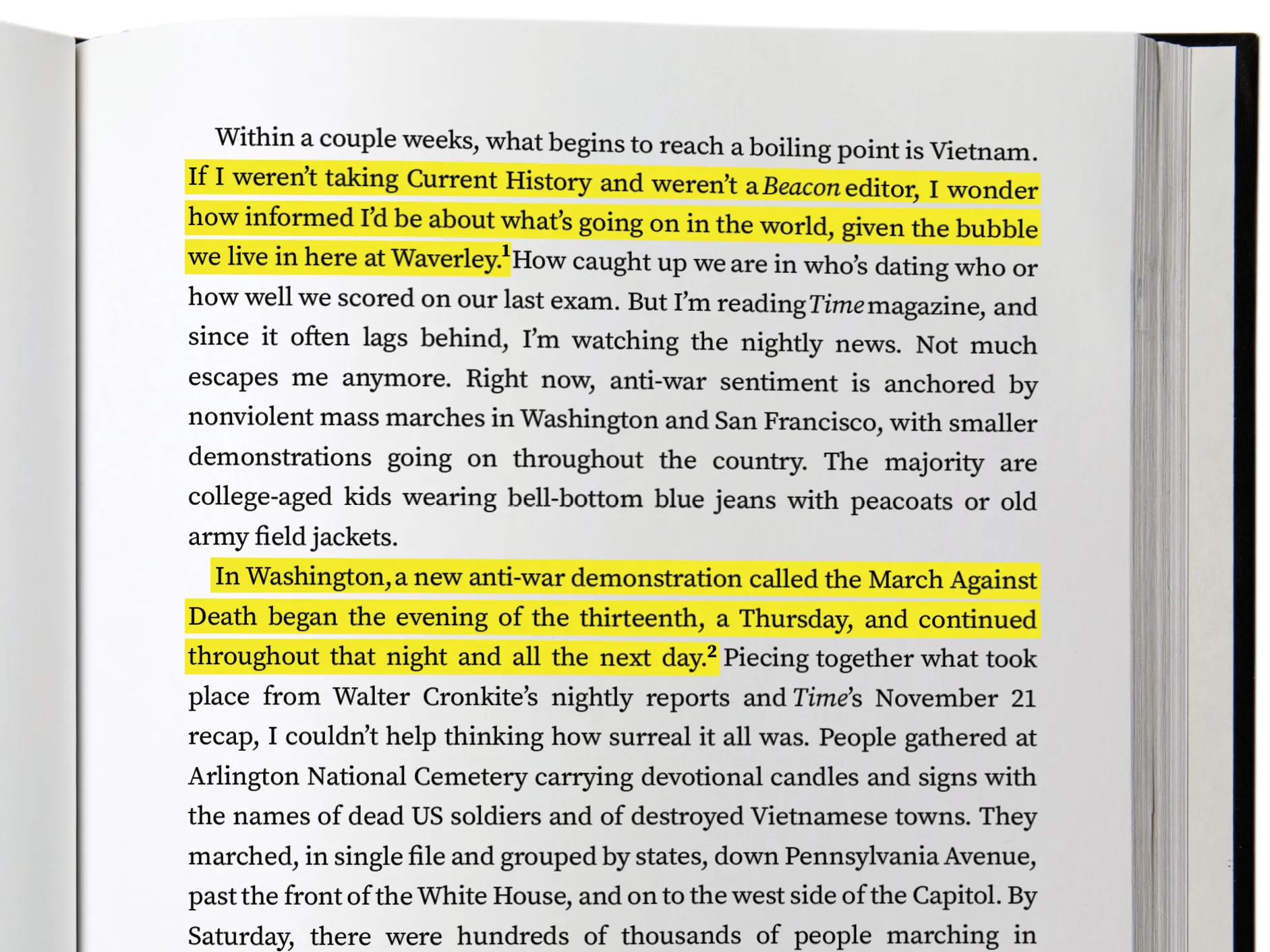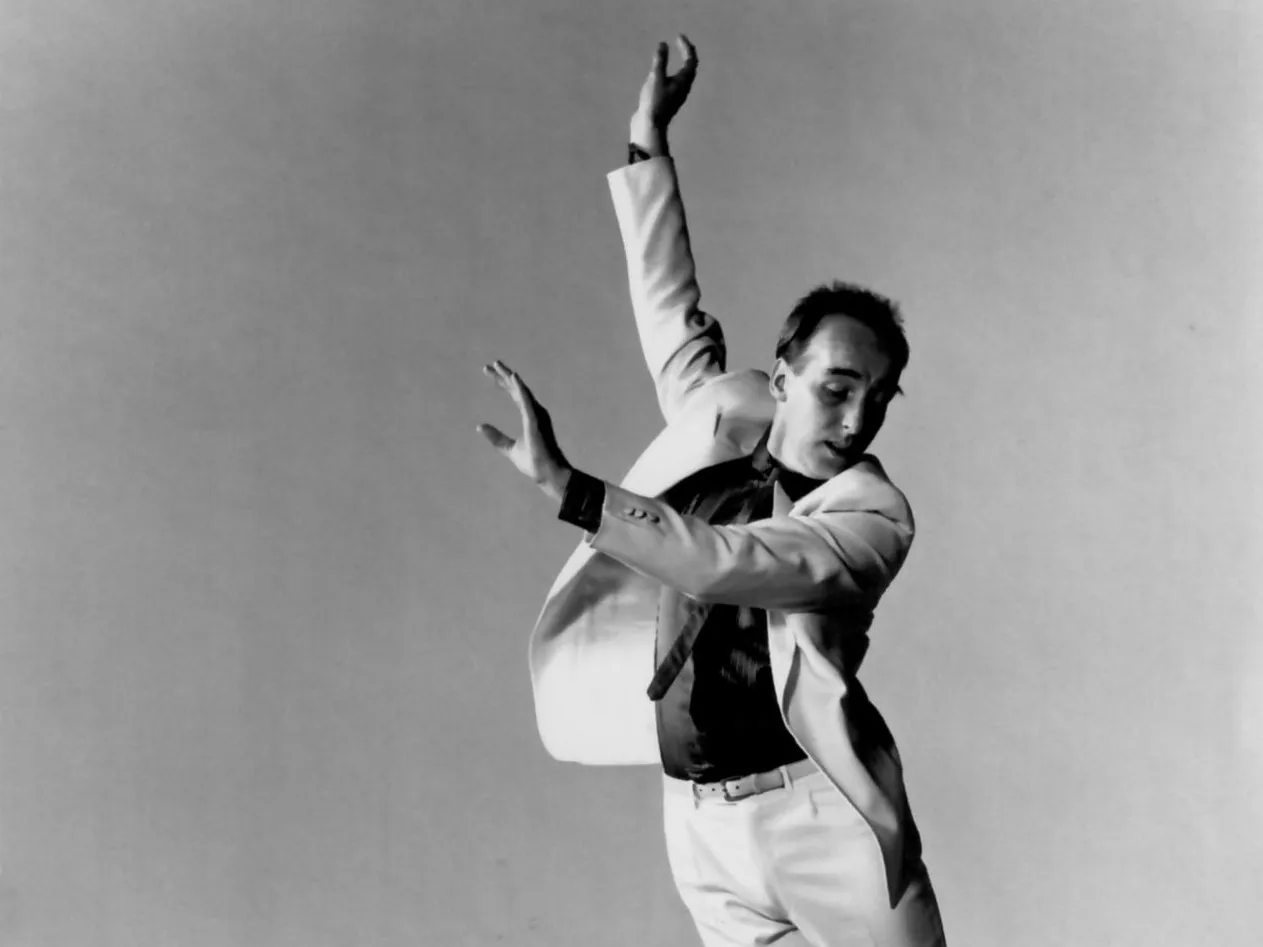If you’re passively admiring art, this alumna would like a word
In Urban Arts Space and Hopkins Hall Gallery, Merijn van der Heijden ’97 MFA sees boundless opportunities to bring together students, faculty and community members through artistic expression and experience.

Merijn van der Heijden, lecturer in Ohio State’s Department of Art and director of the university’s Urban Arts Space and Hopkins Hall Gallery, is constantly connecting students and alumni, campus and community.
Merijn van der Heijden never had that aha! moment — a singular experience that set her course for a future in art. Rather, from the time she was a little girl, she always was making and building. She needed to “activate things” with her hands, she says. She loved working with clay in particular, so she molded a clay birthday cake for her grandmother. By the time she was 11, her parents and teachers noticed her aptitude for drawing; for her other grandmother’s birthday, van der Heijden created her portrait. For her sister, she built an entire suite of dollhouse furniture. By high school, she added sewing and interior decorating to her portfolio.
“When artists and visitors are encouraged to collaborate … and see things in a new way, that’s what art is all about.”
Raised in Tilburg, The Netherlands, van der Heijden ’97 MFA attended the Akademie voor Beeldende Vorming, earning a Bachelor of Fine Arts in Sculpture and Textiles. She cemented her love of art at the academy, reveling in the flexibility and freedom it gave her to more fully explore the conceptual side of art and architecture. And she made a serendipitous connection to her future university when Ohio State art professors Malcolm Cochran, who creates large-scale installations, and Mary Jo Bole, a sculptor and printmaker, visited the academy in a faculty exchange program. Inspired by their work and wanting to extend her education, van der Heijden applied to Ohio State’s graduate program. At age 23, van der Heijden boarded her first airplane — a KLM double-decker jet — and flew to Columbus to begin her graduate work.
After graduating from Ohio State, van der Heijden was hired as assistant director and then interim director of Denison University’s art gallery. She then went to the University of Florida as an assistant professor of art. In 2004, she returned to Ohio State. She has shepherded the College of Arts and Sciences honors program, teaches in the Department of Art, and, since September 2017, has been director of Urban Arts Space and Hopkins Hall Gallery.
With each step in her professional life, she has expanded that idea of activating — from expressing herself with her own hands to inviting artists and their work into settings designed to spark conversation and creativity.
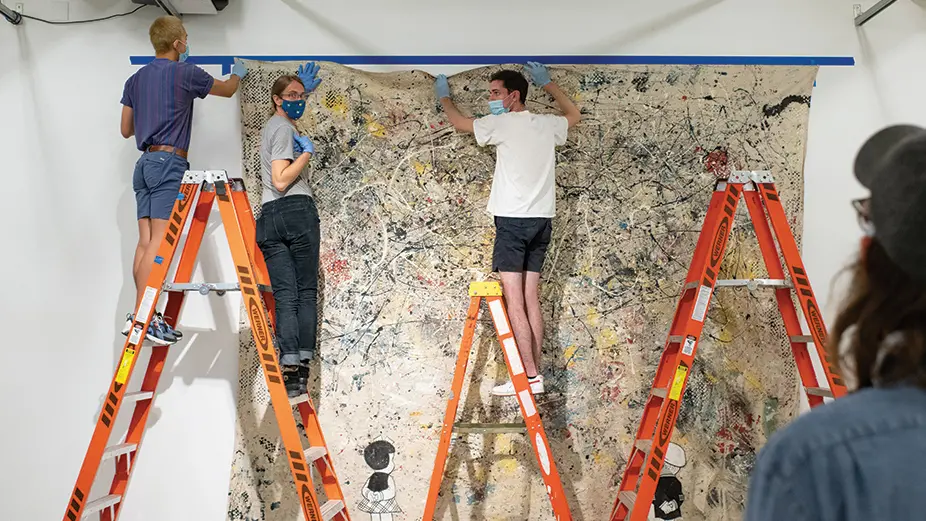
Assisting her are third-year Lucas Ng (left), fifth-year Aaron Burleson and exhibitions manager Jeremy Stone ’10 (looking on).
‘What art is all about’
For van der Heijden, Urban Arts Space and Hopkins Hall Gallery are perfect representations of how Ohio State is a bridge between artists and the broader community, creating accessible and dynamic art spaces that inspire discussion, collaboration and growth. Recently, Hopkins Hall Gallery featured an experimental installation of painting, sculpture and set pieces, representing barriers built and exacerbated by the COVID pandemic. As visitors walked through I Can See Clearly Now, they were invited to discuss the works with artists and graduate students Lydia Smith and Aaron Peters and to intervene in the project by touching, shifting or adding materials. By participating in the art, visitors were both leaving their own marks on the conversation for the next person to experience and walking away with their own new ideas and ways of grappling with the pandemic.
“When artists and visitors are encouraged to collaborate, examine their viewpoints and see things in a new way, that’s what art is all about,” van der Heijden says. “Having spaces where artists can experiment with their work and where visitors are welcome to contribute with their work is an amazing thing.”
Urban Arts Space is an exhibition and nontraditional performance space in a portion of the former Lazarus building in the heart of downtown Columbus. Since it opened in 2008, it has been a professional launching pad for students and a laboratory for local, national and international artists. Its sibling, Hopkins Hall Gallery, is located on Ohio State’s Columbus campus. The gallery showcases the work of students, faculty and staff and conveys university initiatives.
Both spaces provide experiences that challenge perceptions, deepen learning and open access to the arts, right down to admission, which is always free. It’s not unusual to find artists and visitors together in the galleries exchanging and connecting ideas, as though they are extensions of the art itself. For instance, on the second Saturday of each month, Urban Arts Space hosts Art Explorations, which invites children and their families to create art in a gallery setting, with a goal of instilling and deepening appreciation for art.
When COVID-19 closed most Ohio State buildings in spring 2020, van der Heijden and her team designed a suite of new virtual programming to feed the creativity of artists and audiences alike. A new teaching space, the Hybrid Arts Lab, was conceived by arts faculty and colleagues to encourage artistic experimentation and collaboration across Hopkins Hall Gallery, UAS from Home and Stillman Hall Tent, a temporary outdoor performance space. UAS Online started as a series of videos, live presentations and project prompts designed for at-home creativity and has grown to emphasize artexperiences akin to those you’d have in a gallery or museum space. Several of these ideas will outlast the pandemic and be sites of ongoing exhibition and performance.
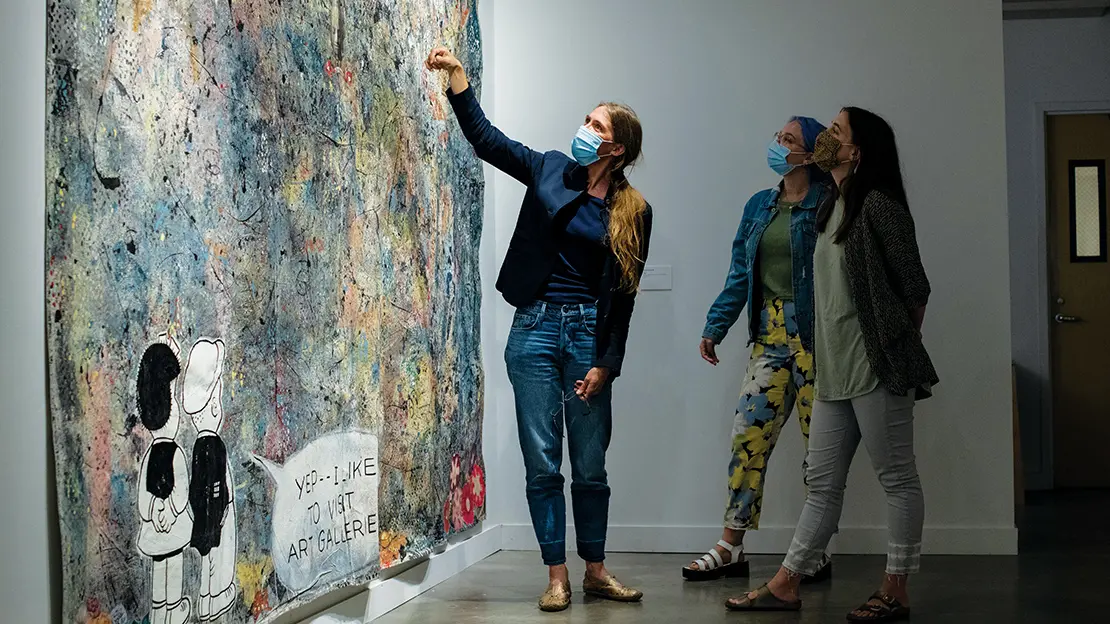
Van der Heijden prepares Side Effects: Paintings by Patrick McDonnell 2016–2021 for exhibition at Ohio State’s Urban Arts Space.
‘Compassion and commitment’
If you talk with van der Heijden for even a few minutes, you realize she is always thinking about art as a medium, a conduit. How it can form neutral ground where people listen, can be vulnerable and learn about themselves and others. “I really believe that art has the ability to be a facilitation mechanism for conversations of social and political issues,” van der Heijden says. “Arts organizations have a responsibility to reach out, engage people and build those conversations — to help people see things in new ways.”
In fall 2020, amid political and societal upheaval over the murder of George Floyd, van der Heijden worked with frequent collaborator Larry Williamson Jr., director of Ohio State’s Frank W. Hale Jr. Black Cultural Center and steward of its vast art collection, to recognize Floyd’s life and to capture the student and community protests through art. The result was One Voice, One Message: Black Lives Matter, an exhibition spanning Hopkins Hall Gallery and UAS Online and featuring the works of photographer Joshua Edmonds. The show was one facet of The HeART of Protest, a 46-day series of protest through art honoring Floyd’s 46 years of life and led by the King Arts Complex in Columbus.
For van der Heijden, this was a critical moment to bear witness and join the conversation. Through art, she says, we can dial down emotions, step back from slogans and focus on the complex questions and history that lie beneath present-day struggles.
“Art has the ability to bring people together, to teach and engage individuals and groups with different points of view, tell stories and teach empathy,” she says. “I believe art is particularly well suited to lead discussions around difficult topics.”
Start at Home: Influence, Commitment, Integrity, a 2019 exhibition organized by Williamson and van der Heijden, included works by H. Ike Okafor-Newsum, Robert J. Stull and Pheoris West, pioneering artists, mentors and teachers. “Merijn and I have worked together for many years,” Williamson says. “She has the compassion and the commitment to make things work.”
More importantly, for Williamson, van der Heijden embraces what diversity and inclusion really mean. “She understands that relationships are built on reciprocity and respect,” he says.
‘Jump in and learn’
Van der Heijden delights in positioning the next generation of artists to succeed. She teaches a course for undergraduates on art and professional practices, preparing them for both the culture and business of art. Students in the course identify and make connections within the business of art and develop a professional presentation and portfolio.
Outside the classroom, she guides students through internships that give them experience in operating a gallery. Internships in exhibitions, programming, communications, video and photo production, and graphic design prepare students for their professional pursuits.
“Nothing is more satisfying than watching students grow, not only in love of their craft but in the skills that will help them navigate life both in and outside of work,” van der Heijden says.
Andy Meyer ’17 graduated with a degree in arts management and a minor in printmaking. He is co-owner of Franklinton Press, an artist-operated printing company based in the Franklinton neighborhood of Columbus. As an undergraduate intern, Meyer took charge of organizing Urban Arts Space exhibition proposals, installations, tours and marketing.
“Merijn gave me the freedom to flex my skills,” he says. “At Urban Arts Space I had to jump in and learn from the bottom up, and it gave me the confidence I needed to start my own business.”
Earlier this year, Meyer was a guest speaker in van der Heijden’s spring class. She underlines the value of students connecting with alumni on academic, internship and career choices that build knowledge, experience and confidence.
“It’s so important for students to hear from their peers and from others who have just recently walked the path they are walking now,” van der Heijden says. “It’s important for them to hear that it is possible to dream big, to take risks and to sometimes fumble through what feels like an impossible challenge — to learn something along the way and thrive.”
Art grows the heart of campus
The 15th Avenue campus gateway is being reimagined as Ohio State’s Arts District, a hub for all visual and performing arts discplines, not just in terms of buildings in proximity but also people in synergy and ideas in exchange.
“I think of the Arts District as a network,” says Merijn van der Heijden, director of Urban Arts Space and Hopkins Hall Gallery. “The boundaries between campus and the community will no longer be so well defined, but more porous, and that’s a wonderful thing.”
The Timashev Family Music Building, supported by a transformational gift from Ratmir ’96 MS and Angela Timashev, and a new building for the Department of Theatre, Film and Media Arts, are under construction now. Both will be equipped with state-of-the-art rehearsal and performance spaces along with floor-to-ceiling windows, inviting spectators to be part of the action. The buildings are expected to open in autumn 2022 and 2023, respectively.
The Arts District is one part of the long-term creative and entrepreneurial vision for the university. The concept began more than a decade ago with renovations to Hopkins Hall (art) and Hayes Hall (design), followed by a $33 million renovation to Sullivant Hall (dance; arts administration, education and policy; the Advanced Computer Center for the Arts and Design; and the Lawrence and Isabel Barnett Center for Integrated Arts and Enterprise).
Centering these disciplines near Wexner Center for the Arts, Billy Ireland Cartoon Library and Museum, and the new headquarters for WOSU Public Media across High Street welcomes the community to campus through the arts and reiterates our commitment to Ohio’s creative economy. Keep up with progress and news on the College of Arts and Sciences’ Arts District web page. — Jennifer Farmer
